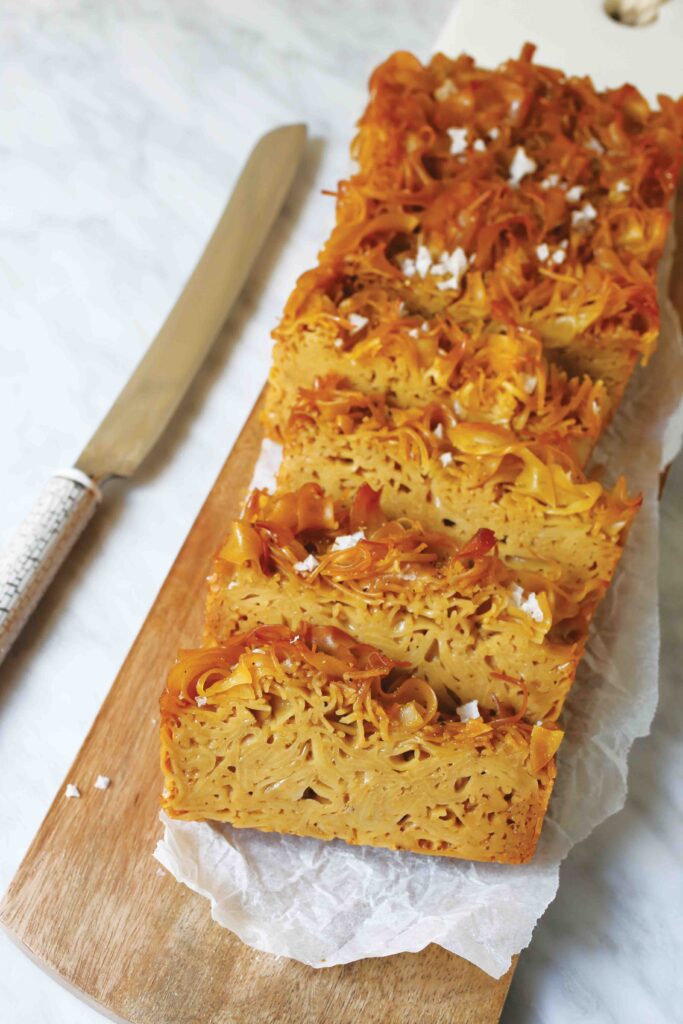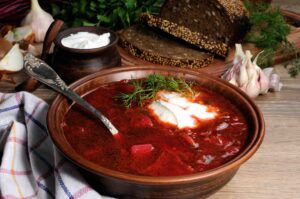Modern Jewish Comfort Food
“The story of Jewish comfort food goes something like this,” writes Shannon Sarna in her latest cookbook “Modern Jewish Comfort Food” (Countryman Press, $30): “We were poor, we didn’t have a lot, so we threw what scraps we had together, and the result was delicious.” With “Modern Jewish Comfort Food” Sarna offers recipes for classic dishes from kugel to kreplach, but adds some Israeli favorites, like a whole chapter on shakshuka, the popular poached egg dish, in various sauces. You’ll find Syrian and Georgian dumplings and pastries and a host of sweets as well.
I caught up with Sarna last month as she demonstrated Israeli Date and Walnut Swirl Cookies from her cookbook. The vegetarian meal, expertly prepared by Chef Liron Regev, included the Yerushalmi kugel featured here. “I’m just a gal who likes to eat. I’m a home cook,” admitted Sarna, whose demo style is relaxed and approachable, just like the recipes in the book. She especially treasures recipes passed down from her bubbe. “These recipes are very beloved comfort food for me. One smell transports me to her house in Yonkers. Those recipes connect us to our history, to the stories of our past.”
Sarna is the editor of the popular Jewish food blog “The Nosher” and is known for her nontraditional challah recipes. Her first cookbook was “Modern Jewish Baker.”
“Yerushalmi kugel, Jerusalem kugel, is a marriage between Europe and the Middle East that tells its own story of the Jewish people’s migration, “explained Sarna. “Eastern European Jews brought the concept of kugel (what is really a word of German origin) to Jerusalem in the 18th and 19th centuries. Traditional noodle kugel transformed slightly, influenced by Sephardic flavors, with lots of black pepper and sugar to caramelize slowly as it bakes.”
Gail Simmons, a judge on Bravo’s Emmy-winning “Top Chef” and author of “Bringing It Home” (Grand Central Life & Style, $30), grew up in a traditional Jewish home, “celebrating the major holidays and observing rites of passage…with way too much food and a little prayer,” she writes. Shabbat, however, was special. “Friday night was a sacred night for our family,” she told me. “We could be busy all week with soccer and dance, but on Friday night my father came home early. All week we had dinner together in the kitchen, but on Friday night we ate in the dining room. My mother and I lit the candles, and my father did the blessings. There were always guests.”
Simmons’ mother ran a cooking school, and the children grew up on leek quiche, Swiss chard and Arctic char. “She’s an ambitious cook ahead of her time, seeking great ingredients,” said Simmons, “but stuffed cabbage and matzo ball soup are very much in her repertoire. She makes a mean chopped liver and gets mad at me for putting wine in the brisket.”
Simmons married a man with a “passion for old Jewish food”: kasha varnishkes, brisket, short ribs, matzo balls. “His favorites are kasha and knishes, the beiger the better,” she said. How refreshing that this sophisticated Top Chef judge, who weekly debates the merits of a red curry gastrique or yuzu gelée, is equally happy to discuss brisket and borsht. “I do high brow and low brow,” she admitted.
At cooking school when Simmons was in her 20s, the teacher tasked the students to cook a dish from their heritage. “As she was also of Eastern European descent, she handed me a book of recipes, reflecting our common lineage,” writes Simmons. “I chose to make borscht, the hearty beet soup. It was a gorgeous recipe: deep, magenta in color, richly flavored with sweet, earthy beets, and brightened with a dash of apple cider vinegar at the finish. I lived on that soup for a whole week, keeping happily connected to my ancestors through its nourishing flavors.” Simmons’ version includes the unconventional sweet potato, apple, and celery. “Caraway seeds add an earthy, warm, anise note and are a key piece of what makes this recipe so complex and alluring,” she writes.
 Winter Borscht
Winter Borscht
For a meat meal use beef broth and add brisket. For a dairy version use vegetable broth and add sour cream.
Yield: 6 to 8 servings
2 tablespoons extra-virgin olive oil, plus more for drizzling
1 medium yellow onion, thinly sliced
Kosher salt
4 garlic cloves, thinly sliced
2 tablespoons tomato paste
2 dried basil leaves
1 teaspoon paprika
1 teaspoon caraway seeds
2 medium beets, scrubbed (not peeled) and trimmed, then shredded using a food processor, or quartered and thinly sliced crosswise
1 small celery root, peeled and shredded using a food processor or quartered and thinly sliced crosswise
1 large carrot (not peeled), thinly sliced into rounds
1 quart low-sodium beef or vegetable broth
1/2 small red cabbage, cord and shredded (about 4 cups)
1 Granny Smith apple, peeled, cored, and cut into 1/4-inch cubes
1 medium sweet potato (not peeled), cut into 1/4 – inch cubes
1/4 cup apple cider vinegar.
Chopped fresh dill for serving
Coarsely ground black pepper
Sour cream for serving, optional
2 cups shredded brisket, optional
1. In a 6– to 8-quart Dutch oven or wide, heavy saucepan with lid, heat oil over medium-high heat. Add onion and 1 teaspoon salt and reduce heat to medium. Cook, stirring occasionally, until onions begin to soften, about 5 minutes. Add garlic and cook 2 minutes more. Stir in tomato paste, bay leaves, paprika, and caraway seeds to coat, then stir in beets, celery, root, and carrot. Add broth and 4 cups of water, bring to a boil, then reduce to a simmer, and cook 15 minutes.
2. Stir in cabbage, apple, and sweet potato, return to a simmer, and continue cooking until cabbage, apple, and sweet potato are just tender, about 5 minutes more. Stir in vinegar and cook just to blend flavors, 3 minutes. Remove and discard bay leaves. Adjust seasoning to taste.
3. Serve hot, topped with dill and pepper, and adding sour cream or brisket, if desired.
Source: “Bringing It Home” by Gail Simmons
Yerushalmi Kugel
Yield: 4 to 6 servings.
Cooking spray for a pan.
12 ounces thin egg noodles
1/3 cup +1 tablespoon neutral oil, such as vegetable, canola, or sunflower.
4 large eggs
2 teaspoons fine sea salt
2 teaspoons freshly ground black pepper
1 teaspoon ground cinnamon
1 cup sugar
Coarse sea salt (optional)
- Preheat oven to 325°F. Grease a 10x5x3“ loaf pan with cooking spray, and set aside.
- Boil noodles in large pot of salted water according to package directions, around 5 minutes.
- Drain noodles. Coat cooked noodles with the tablespoon of oil and set aside.
- Beat eggs in a bowl with fine sea salt, pepper, and cinnamon, then set aside.
- Heat remaining 1/3 cup oil and the sugar in medium saucepan over medium heat, stirring constantly, for around 5 minutes, or until it becomes golden brown. The oil will separate slightly, and that’s normal. You don’t want the caramel to burn.
- When caramel is done, immediately pour on top of the noodles, stirring to coat. Some of the sugar will harden; this is also normal. Add the egg mixture, slowly, mixing it in completely. Pour into prepared pan. Top kugel batter with coarse sea salt, if desired. Cover with foil and bake 1 1/2 hours. Remove from oven and allow to cool slightly before slicing.
Source: “Modern Jewish Comfort Food” by Shannon Sarna
Jlife Food Editor Judy Bart Kancigor is the author of “Cooking Jewish” (Workman) and “The Perfect Passover Cookbook” (an e-book short from Workman), a columnist and feature writer for the Orange County Register and other publications and can be found on the web at www.cookingjewish.com.









